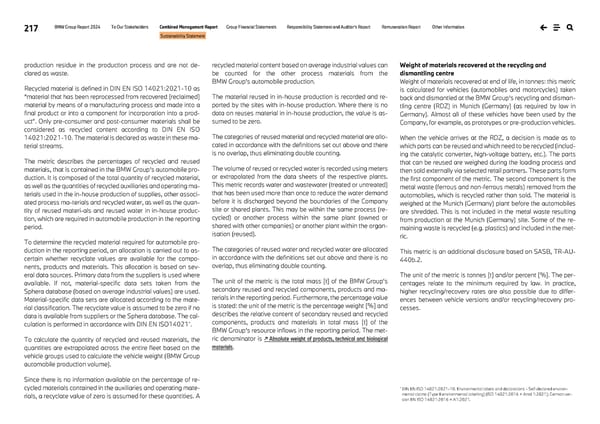217 BMW Group Report 2024 To Our Stakeholders Combined Management Report Group Financial Statements Responsibility Statement and Auditor’s Report Remuneration Report Other Information Sustainability Statement production residue in the production process and are not de- clared as waste. Recycled material is defined in DIN EN ISO 14021:2021-10 as “material that has been reprocessed from recovered [reclaimed] material by means of a manufacturing process and made into a final product or into a component for incorporation into a prod- uct”. Only pre-consumer and post-consumer materials shall be considered as recycled content according to DIN EN ISO 14021:2021-10. The material is declared as waste in these ma- terial streams. The metric describes the percentages of recycled and reused materials, that is contained in the BMW Group’s automobile pro- duction. It is composed of the total quantity of recycled material, as well as the quantities of recycled auxiliaries and operating ma- terials used in the in-house production of supplies, other associ- ated process ma-terials and recycled water, as well as the quan- tity of reused materi-als and reused water in in-house produc- tion, which are required in automobile production in the reporting period. To determine the recycled material required for automobile pro- duction in the reporting period, an allocation is carried out to as- certain whether recyclate values are available for the compo- nents, products and materials. This allocation is based on sev- eral data sources. Primary data from the suppliers is used where available. If not, material-specific data sets taken from the Sphera database (based on average industrial values) are used. Material-specific data sets are allocated according to the mate- rial classification. The recyclate value is assumed to be zero if no data is available from suppliers or the Sphera database. The cal- culation is performed in accordance with DIN EN ISO14021*. To calculate the quantity of recycled and reused materials, the quantities are extrapolated across the entire fleet based on the vehicle groups used to calculate the vehicle weight (BMW Group automobile production volume). Since there is no information available on the percentage of re- cycled materials contained in the auxiliaries and operating mate- rials, a recyclate value of zero is assumed for these quantities. A recycled material content based on average industrial values can be counted for the other process materials from the BMW Group’s automobile production. The material reused in in-house production is recorded and re- ported by the sites with in-house production. Where there is no data on reuses material in in-house production, the value is as- sumed to be zero. The categories of reused material and recycled material are allo- cated in accordance with the definitions set out above and there is no overlap, thus eliminating double counting. The volume of reused or recycled water is recorded using meters or extrapolated from the data sheets of the respective plants. This metric records water and wastewater (treated or untreated) that has been used more than once to reduce the water demand before it is discharged beyond the boundaries of the Company site or shared plants. This may be within the same process (re- cycled) or another process within the same plant (owned or shared with other companies) or another plant within the organ- isation (reused). The categories of reused water and recycled water are allocated in accordance with the definitions set out above and there is no overlap, thus eliminating double counting. The unit of the metric is the total mass [t] of the BMW Group’s secondary reused and recycled components, products and ma- terials in the reporting period. Furthermore, the percentage value is stated: the unit of the metric is the percentage weight [%] and describes the relative content of secondary reused and recycled components, products and materials in total mass [t] of the BMW Group’s resource inflows in the reporting period. The met- ric denominator is ↗ Absolute weight of products, technical and biological materials. Weight of materials recovered at the recycling and dismantling centre Weight of materials recovered at end of life, in tonnes: this metric is calculated for vehicles (automobiles and motorcycles) taken back and dismantled at the BMW Group’s recycling and disman- tling centre (RDZ) in Munich (Germany) (as required by law in Germany). Almost all of these vehicles have been used by the Company, for example, as prototypes or pre-production vehicles. When the vehicle arrives at the RDZ, a decision is made as to which parts can be reused and which need to be recycled (includ- ing the catalytic converter, high-voltage battery, etc.). The parts that can be reused are weighed during the loading process and then sold externally via selected retail partners. These parts form the first component of the metric. The second component is the metal waste (ferrous and non-ferrous metals) removed from the automobiles, which is recycled rather than sold. The material is weighed at the Munich (Germany) plant before the automobiles are shredded. This is not included in the metal waste resulting from production at the Munich (Germany) site. Some of the re- maining waste is recycled (e.g. plastics) and included in the met- ric. This metric is an additional disclosure based on SASB, TR-AU- 440b.2. The unit of the metric is tonnes [t] and/or percent [%]. The per- centages relate to the minimum required by law. In practice, higher recycling/recovery rates are also possible due to differ- ences between vehicle versions and/or recycling/recovery pro- cesses. * DIN EN ISO 14021:2021-10. Environmental labels and declarations - Self-declared environ- mental claims (Type II environmental labelling) (ISO 14021:2016 + Amd 1:2021); German ver- sion EN ISO 14021:2016 + A1:2021.
 BMW Group Report 2024 Page 216 Page 218
BMW Group Report 2024 Page 216 Page 218